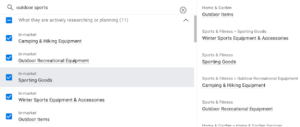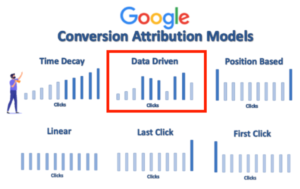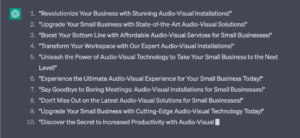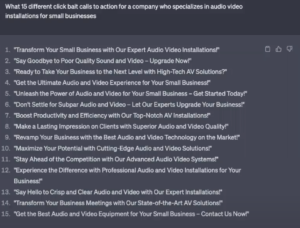Over the past few years, the rise of Artificial Intelligence has provided businesses with powerful tools to enhance their PPC advertising endeavors. Utilizing AI in PPC advertising has empowered marketers to analyze, and fine-tune their campaigns to accomplish their intended objectives. What follows is a look at the impact AI tools are bringing to the world of PPC advertising.
Automated Bidding
AI-powered bidding algorithms can analyze vast amounts of data and make real-time bidding decisions to optimize your campaigns for your desired outcome. This means that your campaigns can be adjusted in real-time, based on the data and insights gathered by the AI.
Audience Targeting
AI also enables marketers to analyze data to identify and target specific audiences based on their behavior, interests, and demographics. This allows us to identify patterns and insights to create audience segments that are most likely to convert.
Example, let’s say you are a retailer selling high-end sports equipment, and you want to target potential customers who are interested in outdoor sports. You can use Google’s AI-powered audience targeting feature to create an audience of users who have shown an interest in outdoor sports, such as hiking or mountain biking. The AI algorithms analyze various data points, such as search history, location, device, and browsing behavior, to identify users who are most likely to be interested in your products. You can then create campaigns that target this audience with tailored ad copy and creative that speaks to their interests.
Data Driven Attribution
Data-driven attribution is an advanced attribution model that uses machine learning. “DDA” analyzes the customer journey data, and assigns credit to the different touch-points that lead to a conversion. Data Driven Attribution has become Google’s default attribution model. Unlike other attribution models, data-driven attribution takes into account all touch-points in a customer journey, as well as the order and timing of those touch-points. It uses statistical models to analyze this data and determine which touch points are most influential in driving conversions.
The benefits of using data-driven attribution include:
- Improved accuracy: Data-driven attribution provides a more accurate picture of the customer journey and which touch-points are most effective in driving conversions.
- Smarter decision-making: By understanding which touch-points are most effective, advertisers can make more informed decisions about where to allocate their ad spend and how to optimize their campaigns.
- Increased efficiency: By focusing on the touch-points that are most effective, advertisers can optimize their campaigns to drive more conversions with less ad spend.
Additional Attribution models include:
- Last Click Attribution: This model attributes all credit to the last touchpoint that a user interacted with before converting. This model assumes that the last touchpoint was the most critical. If you are utilizing a smart bidding strategy such as max conversions, we recommend not using last click. Smart bidding needs multiple touch points to analyze to effectively determine the path of least resistance when converting.
- First Click Attribution: This model attributes all credit to the first touchpoint that a user interacted with before converting. This model assumes that the first touchpoint was the most critical and is ideal for campaigns focused on introducing new products or services.
- Linear Attribution: This model distributes credit equally across all touch-points that a user interacted with before converting. This model assumes that all touch-points are equally important.
- Time Decay Attribution: This model gives more credit to touch-points that are closer in time to the conversion event. The closer a touchpoint is to the conversion event, the more credit it receives. This model assumes that touch-points closer to the conversion event were more influential and is ideal for campaigns with a longer customer journey.
- Position-Based Attribution: This model attributes 40% of the credit to the first and last touch-points, with the remaining 20% distributed evenly among the touch-points in between. This model assumes that the first and last touch-points are the most critical and is ideal for campaigns that focus on generating both initial interest and driving final conversions.
One of the most recent applications of Artificial Intelligence in PPC advertising in 2023 is the use of AI as it relates to writing ad copy. One example of a powerful AI tool that businesses can use to improve their ad copy is ChatGPT. ChatGPT is a type of open AI that is capable of generating human-like responses. By leveraging the power of ChatGPT, businesses can create more compelling and persuasive ad copy that resonates with their target audience. Here are three examples of how to use ChatGPT to improve ad copy:
- Writing Better Headlines: Chat GPT can be used to generate catchy headlines that grab attention and encourage users to click through to the ad.
- Example, let’s say you have a company that specializes in audio/video installations for small businesses. You can enter the following prompt: Write 10 clickbait headlines, inspired by (Enter company’s value prop/current asset relating to their audio/video services Chat GPT will then populate various versions of ad copy to build from.
- Crafting Compelling Calls-to-Action: With Chat GPT, digital marketers can also generate persuasive calls-to-action that drive conversions, such as “Click here to get started” or “Sign up now to receive your free trial.”
- Example, you can enter the following prompt: Write 10 clickbait headlines that include a variety of different CTA’s. Focus on audio/video services (Input services/products as you deem fit) Keep in mind if you are not satisfied with the output, you can continue to regenerate responses to populate different results.
- Generating Ad Copy for Different Channels: Different channels require different messaging styles and formats. With Chat GPT, digital marketers can generate ad copy that is tailored to specific channels, such as social media or search ads.
- Example, you can enter the following prompt: Write a RSA (Responsive Search Ad) for Google Ads based on the following (Enter details/value proposition of your product or service) Chat GPT will then proceed to provide various headlines and descriptions that respect Google’s guidelines when creating an RSA. This is a very useful tool, especially when you hit a creative block!
In conclusion, the integration of AI technology in PPC advertising is revolutionizing the digital marketing landscape by providing new and innovative ways for businesses to connect with their target audience. AI-powered tools and algorithms are enabling marketers to create more personalized, targeted and effective PPC ads that better resonate with their audience. By leveraging the power of AI, businesses can gain a competitive edge in the constantly evolving digital landscape, and achieve greater success with their PPC advertising campaigns. The adoption of AI in PPC advertising is becoming increasingly critical for businesses looking to optimize their advertising efforts and drive better results.










